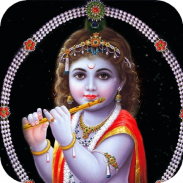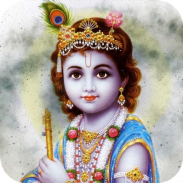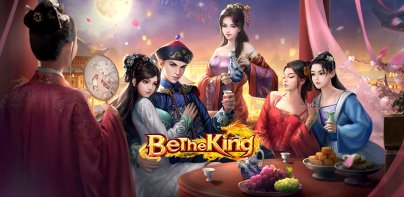




1008 Names Of Sri Krishna श्री कृष्णा के १००८ नाम

وصف لـ1008 Names Of Sri Krishna श्री कृष्णा के १००८ नाम
Krishna Mantras | OFFLINE | HD Audio | Repeat Option | FREE | HD God images
Krishna is an ancient Indian king and a Hindu deity, worshipped across many traditions of Hinduism in a variety of different perspectives. Krishna is recognized as the complete and eighth avatar of the God Vishnu or as the Supreme God in his own right. Krishna is one of the most widely revered and popular of all Hindu deities. If a historical person, Krishna under the name of 'Vasudeva Govinda Krishna Shauri' would have flourished as the ruler of Shuraseni and Vrishni tribes on the now-submerged island of Dwaraka (Off coast Gujarat, India) sometime between 3200-3100 BC. Believed to have been born on 21 July 3227 BC, Krishna's birthday is celebrated every year by Hindus on the eighth day (Ashtami) of the Krishna Paksha (dark fortnight) of the month of Bhadrapad in the Hindu calendar.
Krishna is a name of the original, unique Supreme Person, the source of all that exists. The name Krishna—"the all-attractive one"—indicates the unequaled charm and beauty of the Supreme Person, as He appears to His most dear devotees.
Krishna appears as other forms of God—avatars—to create and maintain the universe, while He simultaneously enjoys loving relationships with His countless associates in the spiritual world. He visits this material world from time to time to free His devotees from material existence and to vanquish the wicked. He performs superhuman pastimes—lifting mountains, swallowing forest fires, and killing numerous extraordinarily powerful demons—as easily as a child playing with toys.
1008 Names Of Sri Krishna श्री कृष्णा के १००८ नाम
Krishna Gayatri Mantra कृष्णा गायत्री मंत्र
Shri Krishna Chalisa श्री कृष्णा चालीसा
108 names of Sri Krishna श्री कृष्णा के १०८ नाम
Shree Ram Jai Ram Jai Jai Ram श्री राम जय राम जय जय राम
Namo Bhagwate Vasudevay नमो भगवते वासुदेवाय
Sri Krishna Sharanam Mamah श्री कृष्णा शरणम ममः
Achutam Keshavam अच्चुतम केशवम
Krishna Kavacham कृष्णा कवचं
Hare Krishna हरे कृष्णा
Vasudev Sutamdevam वासुदेव सुतामदेवं
Krishna is represented in the Indian traditions in many ways, with some common features. His iconography typically depicts him as black or dark reflecting his name, or with blue skin like Vishnu. However ancient and medieval reliefs and stone-based arts depict him in the natural color of the material he is made from, both in India and in southeast Asia.In some texts, his skin is poetically described as the color of Jambul (Jamun, a purple-colored fruit).
Krishna is often depicted wearing a peacock feather wreath or crown, and in a pose playing the bansuri (Indian flute). In this form, he usually stands with one leg bent in front of the other in the Tribhanga posture. He is sometimes accompanied by cows or a calf, symbolism for the divine herdsman Govinda. Alternatively, he is shown as an amorous man with the gopis (milkmaids), often making music or playing pranks.
Krishna lifting Govardhana at Bharat Kala Bhavan, recovered from a Muslim graveyard in Varanasi. It is dated to be from the Gupta Empire era (4th/6th-century CE).
In other icons, he is a part of the scene on the battlefield of the epic Mahabharata. He is shown as a charioteer, notably where he addresses Pandava prince Arjuna character of the Mahabharata, symbolically reflecting the events that led to the Bhagavad Gita – a scripture of Hinduism. In these popular depictions, Krishna is in the front as the charioteer, either as a counsel listening to Arjuna, or as driving the chariot while Arjuna aims his archery in the battle-field of Kurukshetra.
K, kri, kris, krish, krishna, krihna, krushna





















